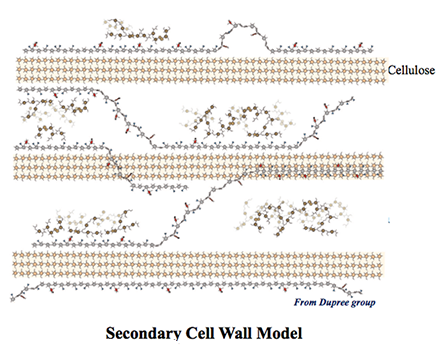
Wood in the stems of trees is almost entirely composed of cell wall materials. The secondary cell wall consists of an elaborate network of cellulose microfibrils surrounded by non-cellulosic polysaccharides, lignin and proteins and water. The complex and rigid structure is critical for the maintenance of the cell structure of xylem vessels and fibers, and confers mechanical properties to wood materials. However, the molecular architecture of the cell wall also provides a challenge in the use of wood materials in industrial applications. It is important to understand how the components of the cell wall interact, so that we can predict the mechanical properties of timber under different conditions. We aim to develop better methods to modify wood properties for various industrial processes.
Our research is focused on the structure of cellulose and hemicelluloses, including xylan and galactoglucomannan, and their functions in conferring mechanical properties to timbers. We are using reverse genetics, cell biology, solid state nuclear magnetic resonance and biochemical methods to analyse the hemicellulose backbone structure and side chain patterns and how various hemicelluloses interact with cellulose microfibrils.
Xylan is the most abundant non-cellulosic polysaccharides in hardwood. It is also found in softwood. It contains a linear backbone with β-1,4-linked D-xylose residues, which may be substituted by acetyl groups, glucuronic acid, 4-O-methylglucuronic acid, arabinose, and rarely galactose. We believe that the presence of substitutions on the xylan backbone determines the binding style to cellulose microfibrils, and then determines timber properties. Now we are working on the xylan backbone length, side chain patterns and how the side chains affect hemicelluloses interactions with cellulose. In softwood, galactoglucomannans are the major components of the secondary walls. It consists of a backbone made of β-1,4-linked D-glucose and D-mannose units. The mannosyl residue in the backbone can be substituted with an α-1,6-linked galactosyl residue. In addition, the mannosyl residue can be O-acetylated at the O-2 or O-3 position. We have limited knowledge on the structure of galactoglucomannans. Now we are using softwood to study how it interacts with cellulose
Reference:
Cellulose: New understanding could lead to railroad biofuels.
Golgi-localized STELLO proteins regulate the assembly and trafficking of cellulose synthase complexes in Arabidopsis. Nature Communications 7, Article number: 11656 doi:10.1038/ncomms11656
